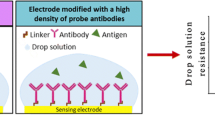Abstract
We report an important observation that the surface conductivity of antibody layer immobilized on polylysine-coated glass substrate decreases upon the formation of complex with their specific antigens. This change in conductivity has been observed for both monoclonal and polyclonal antibodies. The conductance of monoclonal mouse IgG immobilized on polylysine-coated glass substrate changed from 1.02×10−8 Ω−1 to 1.41×10−11 Ω−1 at 10 V when complex is formed due to the specific biomolecular interactions with rabbit anti-mouse IgG F(ab′)2. Similar behavior was observed when the same set up was tested in two clinical assays: (1) anti-Leishmania antigen polyclonal antibodies taken from Kala Azar positive patient serum interacting with Leishmania promastigote antigen, and (2) anti-p21 polyclonal antibodies interacting with p21 antigen. The proposed concept can represent a new immunodiagnostic technique and may have wide ranging applications in biosensors and nanobiotechnology too.
Similar content being viewed by others
References
Long, Y.T., Abu-Irhayem, E., Kraatz, H.B., 2005. Peptide electron transfer: more questions than answers. Chem. Eur. J., 11(18):5186–5194. [doi:10.1002/chem.200500143]
Schlag, E.W., Sheu, S.Y., Yang, D.Y., Selzle, H.L., Lin, S.H., 2000a. Charge conductivity in peptides: dynamic simulations of a bifunctional model supporting experimental data. Proc. Natl. Acad. Sci. USA, 97(3):1068–1072. [doi:10.1073/pnas.97.3.1068]
Schlag, E.W., Yang, D.Y., Sheu, S.Y., Selzle, H.L., Lin, S.H., Rentzepis, P.M., 2000b. Dynamical principles in biological processes: a model of charge migration in proteins and DNA. Proc. Natl. Acad. Sci. USA, 97(18):9849–9854. [doi:10.1073/pnas.140196597]
Sheu, S.Y., Schlag, E.W., 2002. Protein charge transport in gas phase. Int. J. Mass Spectrometry, 219(1):73–77. [doi:10.1016/S1387-3806(02)00586-9]
Sheu, S.Y., Yang, D.Y., Selzle, H.L., Schlag, E.W., 2002. Charge transport in a polypeptide chain. Eur. Phys. J. D, 20(3):557–563. [doi:10.1140/epjd/e2002-00154-7]
Weinkauf, R., Schanen, P., Yang, D., Soukara, S., Schlag, E.W., 1995. Elementary processes in peptides: electron mobility and dissociation in peptide cations in the gas phase. J. Phys. Chem., 99(28):11255–11265. [doi:10.1021/j100028a029]
Weinkauf, R., Schanen, P., Metsala, A., Schlag, E.W., Burgle, M., Kessler, H., 1996. Highly efficient charge transfer in peptide cations in the gas phase—Threshold effects and mechanism. J. Phys. Chem., 100(47):18567–18585. [doi:10.1021/jp960926m]
Weinkauf, R., Schlag, E.W., Martinez, T.J., Levine, R.D., 1997. Nonstationary electronic states and site-selective reactivity. J. Phys. Chem. A, 101(42):7702–7710. [doi:10.1021/jp9715742]
Author information
Authors and Affiliations
Rights and permissions
About this article
Cite this article
Vashist, S.K., Kaur, I., Bajpai, R.P. et al. Demonstration of a new biosensing concept for immunodiagnostic applications based on change in surface conductance of antibodies after biomolecular interactions. J. Zhejiang Univ. - Sci. B 7, 683–685 (2006). https://doi.org/10.1631/jzus.2006.B0683
Received:
Accepted:
Issue Date:
DOI: https://doi.org/10.1631/jzus.2006.B0683




